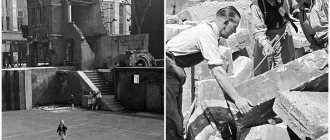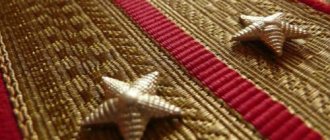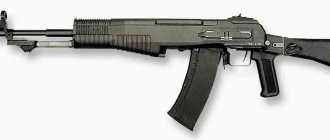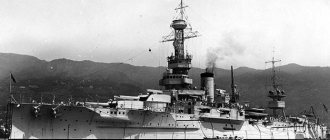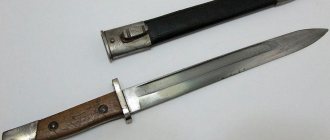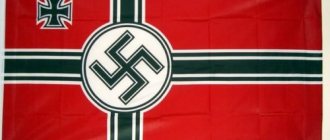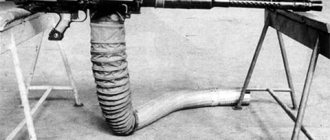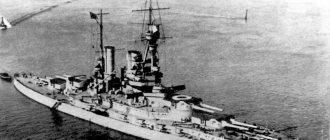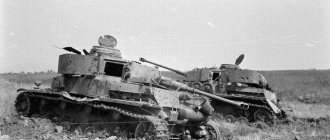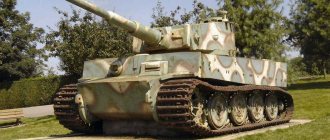The SS troops belonged to the SS organization; service in them was not considered state service, even if it was legally equivalent to such. The military uniform of SS soldiers is quite recognizable all over the world; most often this black uniform is associated with the organization itself. It is known that the uniforms for SS employees during the Holocaust were sewn by prisoners of the Buchenwald concentration camp.
History of creation
The abbreviation SS was first used to designate Hitler's personal paramilitary security unit in 1925.
The leader of the Nazi Party surrounded himself with security even before the Beer Hall Putsch. However, it acquired its sinister and special meaning only after it was re-written for Hitler, who was released from prison. At that time, SS ranks were still extremely stingy - there were groups of ten people, headed by the SS Fuhrer.
The main purpose of this organization was to protect members of the National Socialist Party. SS military ranks appeared much later, when the Waffen-SS was formed. These were precisely those parts of the organization that we remembered most vividly, since they fought at the front, among ordinary Wehrmacht soldiers, although they stood out among them in many ways. Before this, the SS was, although paramilitary, a “civilian” organization.
Interpretation of the concept "Wehrmacht"
These are the “defense forces” in 1935 - 1945. In other words, the Wehrmacht (photo below) is nothing more than the armed forces of Nazi Germany. It is headed by the Supreme Command of the country's armed forces, which subordinates the ground forces, the Navy and Air Force, and the SS troops. They were led by the main commands (OKL, OKH, OKM) and the commanders-in-chief of various types of armed forces (since 1940, also the SS troops). The Supreme Commander-in-Chief of the Wehrmacht is Reich Chancellor A. Hitler. A photo of Wehrmacht soldiers is shown below.
According to historical data, the word in question in German-speaking countries denoted the armed forces of any country. It acquired its usual meaning when the NSDAP came to power.
On the eve of World War II, the Wehrmacht numbered approximately three million people, and its maximum strength was 11 million people (as of December 1943).
Formation and activity
As mentioned above, initially the SS was just the personal guard of the Fuhrer and some other high-ranking party members. However, gradually this organization began to expand, and the first signal foreshadowing its future power was the introduction of a special SS rank. We are talking about the position of Reichsfuhrer, then simply the chief of all SS Fuhrers.
The second important moment in the rise of the organization was permission to patrol the streets along with the police. This made the SS members no longer just guards. The organization has turned into a full-fledged law enforcement service.
However, at that time, the military ranks of the SS and the Wehrmacht were still considered equivalent. The main event in the formation of the organization can be called, of course, the accession to the post of Reichsführer Heinrich Himmler. It was he who, while simultaneously serving as head of the SA, issued a decree that did not allow any of the military to give orders to members of the SS.
At that time, in the German army, this decision, understandably, was accepted with hostility. Moreover, along with this, a decree was immediately issued that demanded that all the best soldiers be placed at the disposal of the SS. In fact, Hitler and his closest associates pulled off a brilliant scam.
Indeed, among the military class, the number of adherents of the National Socialist labor movement was minimal, and therefore the heads of the party seizing power understood the threat posed by the army. They needed firm confidence that there were people who would take up arms on the orders of the Fuhrer and would be ready to die while carrying out the tasks assigned to him. Therefore, Himmler actually created a personal army for the Nazis.
The main purpose of the new army
These people performed the dirtiest and lowest, from a moral point of view, work. Concentration camps were under their responsibility, and during the war, members of this organization became the main participants in punitive purges. SS ranks appear in every crime committed by the Nazis.
The final victory of the authority of the SS over the Wehrmacht was the appearance of SS troops - later the military elite of the Third Reich. No general had the right to subjugate a member of even the lowest rung in the organizational ladder of the “security detachment,” although the ranks in the Wehrmacht and SS were similar.
Selection
To get into the SS party organization, one had to meet many requirements and parameters. First of all, SS ranks were given to men with an absolutely Aryan appearance. Their age at the time of joining the organization should have been 20-25 years. They were required to have the “correct” structure of the skull and absolutely healthy white teeth. Most often, joining the SS ended the “service” in the Hitler Youth.
Appearance was one of the most important selection parameters, since people who were members of the Nazi organization were destined to become the elite of the future German society, “equals among unequals.” It is clear that the most important criterion was endless devotion to the Fuhrer and the ideals of National Socialism.
However, such an ideology did not last long, or rather, it almost completely collapsed with the advent of the Waffen-SS. During the Second World War, Hitler and Himmler began to recruit everyone who showed desire and proved loyalty into the personal army. Of course, they tried to preserve the prestige of the organization by assigning only SS ranks to newly recruited foreigners and not accepting them into the main cell. After serving in the army, such individuals were supposed to receive German citizenship.
In general, the “elite Aryans” very quickly “ended up” during the war, being killed on the battlefield and taken prisoner. Only the first four divisions were completely “staffed” by pure race, among which, by the way, was the legendary “Death’s Head”. However, already the 5th (“Viking”) made it possible for foreigners to receive SS ranks.
Divisions
The most famous and ominous is, of course, the 3rd Tank Division “Totenkopf”. Many times she completely disappeared, being destroyed. However, it was revived again and again. However, the division gained fame not because of this, and not because of any successful military operations. “The Death’s Head” is, first of all, an incredible amount of blood on the hands of military personnel. It is this division that accounts for the largest number of crimes against both the civilian population and prisoners of war. Rank and title in the SS did not play any role during the tribunal, since almost every member of this unit managed to “distinguish themselves.”
The second most legendary was the Viking division, recruited, according to the Nazi formulation, “from peoples close in blood and spirit.” Volunteers from Scandinavian countries entered there, although their number was not overwhelming. Basically, only Germans still held SS ranks. However, a precedent was created, because Viking became the first division to recruit foreigners. For a long time they fought in the south of the USSR, the main place of their “exploits” was Ukraine.
"Galicia" and "Rhone"
The Galicia division also occupies a special place in the history of the SS. This unit was created from volunteers from Western Ukraine. The motives of people from Galicia who received German SS ranks were simple - the Bolsheviks came to their land just a few years ago and managed to repress a considerable number of people. They joined this division not out of ideological similarity with the Nazis, but for the sake of the war against the communists, whom many Western Ukrainians perceived in the same way as citizens of the USSR perceived the German invaders, i.e., as punitive and murderers. Many went there out of a thirst for revenge. In short, the Germans were looked upon as liberators from the Bolshevik yoke.
This view was typical not only of residents of Western Ukraine. The 29th Division "RONA" gave SS ranks and shoulder straps to Russians who had previously tried to gain independence from the communists. They got there for the same reasons as the Ukrainians - a thirst for revenge and independence. For many people, joining the ranks of the SS seemed like a real salvation after a life broken by the 30s under Stalin.
At the end of the war, Hitler and his allies went to extremes just to keep people associated with the SS on the battlefield. They began to recruit literally boys into the army. A striking example of this is the Hitler Youth division.
In addition, on paper there are many units that were never created, for example, the one that was supposed to become Muslim (!). Even blacks sometimes ended up in the ranks of the SS. Old photographs testify to this.
Of course, when it came to this, all elitism disappeared, and the SS became simply an organization under the leadership of the Nazi elite. The recruitment of “imperfect” soldiers only shows how desperate Hitler and Himmler were at the end of the war.
Famous representatives of this rank in Germany
Over the course of several decades, many German officers were awarded this rank. But we will remember those whose names remained in history for a long time.
For example, this title was held by Otto Skorzeny, a German military engineer who became interested in the ideas of National Socialism and became Hitler’s loyal ally. It was Skorzeny who took part in the German offensive against Moscow. In 1941, he saw the golden domes of the Moscow Kremlin from his binoculars and dreamed of entering the city with a victorious march. However, this did not happen. Later, in his memoirs, the German colonel described both the terrible cold and the courage of the Russian soldiers, as well as the discord in the German troops, which he first saw and was amazed by.
An experienced military man, Skorzeny realized after 1942 that the Russians were very formidable opponents who would be extremely difficult to defeat. Therefore, the colonel, out of harm’s way, tried to lead the SS troops, one of whose units was responsible for reconnaissance. It was the brave Skorzeny who led the operation during which the Germans managed to kidnap Mussolini himself. True, for the great Italian dictator, Germany's intercession was costly: it led him to death.
Skorzeny managed to survive the Third Reich. After the war, he was arrested, but escaped in 1948, after which he wandered around Europe, writing memoirs, trying to understand the reason for the defeat of Nazi Germany in the terrible Second World War.
Reichsfuehrer
The most famous head of the SS was, of course, Heinrich Himmler. It was he who made the Fuhrer’s guard a “private army” and held the post of its leader the longest. This figure is now largely mythical: it is impossible to clearly say where fiction ends and where the facts from the biography of a Nazi criminal begin.
Thanks to Himmler, the authority of the SS was finally strengthened. The organization became a permanent part of the Third Reich. The SS rank he held effectively made him commander-in-chief of Hitler's entire personal army. It must be said that Heinrich approached his position very responsibly - he personally inspected concentration camps, conducted inspections in divisions, and participated in the development of military plans.
Himmler was a truly ideological Nazi and considered serving in the SS his true calling. The main goal of his life was the extermination of the Jewish people. Perhaps the descendants of Holocaust victims should curse him more than Hitler.
Due to the impending fiasco and Hitler's increasing paranoia, Himmler was accused of treason. The Fuhrer was sure that his ally had entered into an agreement with the enemy in order to save his life. Himmler lost all high posts and titles, and his place was to be taken by the famous party leader Karl Hanke. However, he did not have time to do anything for the SS, since he simply could not take office as Reichsfuehrer.
Structure
The SS Army, like any other paramilitary force, was strictly disciplined and well organized.
The smallest unit in this structure was the Shar-SS department, consisting of eight people. Three similar army units formed the troupe-SS - according to our concepts, this is a platoon.
The Nazis also had their own equivalent of a Sturm-SS company, consisting of about one and a half hundred people. They were commanded by an Untersturmführer, whose rank was the first and most junior among the officers. From three such units, the Sturmbann-SS was formed, headed by a Sturmbannführer (the rank of major in the SS).
And finally, the Standar-SS is the highest administrative-territorial organizational unit, analogous to a regiment.
Apparently, the Germans did not reinvent the wheel and spend too much time looking for original structural solutions for their new army. They just selected analogues of conventional military units, giving them a special, excuse me, “Nazi flavor”. The same situation happened with ranks.
How to translate this military rank? What does it mean?
If we turn to the translation, this word can be considered as “commander of a military unit”, which in German is called “standard”. This term appeared after the revolution in Germany, when the Kaiser's empire fell. Historians date the appearance of this title to 1929. Then there was a period of active transformation of the German army. At that time, the German army was experiencing a turbulent period of returning its former power, new types of troops and units were being created that needed leaders.
It should be noted that the SS Standartenführer had a fairly high rank, which corresponded to the current colonel. Up to 4 thousand people could be subordinated to such a military man, and, as a rule, the standard included the male population of a small town. It was assumed that, in addition to the chief, there were three more Stumbann (lieutenant colonels) and one reserve Stumbann (who had the rank of major in Russian).
Ranks
The military ranks of the SS Troops were almost completely similar to the ranks of the Wehrmacht.
The youngest of all was a private, who was called a Schütze. Above him stood the equivalent of a corporal - a Sturmmann. So the ranks rose to officer untersturmführer (lieutenant), continuing to remain modified simple army ranks. They walked in this order: Rottenführer, Scharführer, Oberscharführer, Hauptscharführer and Sturmscharführer.
After this, the officers began their work. The highest ranks were general (Obergruppenführer) of the military branch and colonel general, called Oberstgruppenführer.
All of them were subordinate to the commander-in-chief and head of the SS - the Reichsfuehrer. There is nothing complicated in the structure of SS ranks, except perhaps the pronunciation. However, this system is built logically and in an army-like manner, especially if you add up the ranks and structure of the SS in your head - then everything generally becomes quite simple to understand and remember.
Army ranks
They were presented as follows:
- privates;
- non-commissioned officers without belts (a braided or belt sling for carrying a tashka, bladed weapons, and later firearms);
- non-commissioned officers with sword belts;
- lieutenants;
- captains;
- staff officers;
- generals.
Combat ranks also extended to military officials of various departments and departments. The military administration was divided into categories from the most junior non-commissioned officers to the noble generals.
Marks of Excellence
It is interesting to study ranks and titles in the SS using the example of shoulder straps and insignia. They were characterized by a very stylish German aesthetic and truly reflected everything that the Germans thought about their achievements and purpose. The main theme was death and ancient Aryan symbols. And if the ranks in the Wehrmacht and the SS were practically the same, the same cannot be said about shoulder straps and stripes. So what's the difference?
The shoulder straps of the rank and file were nothing special - an ordinary black stripe. The only difference is the stripes. The junior officers were not far away, but their black shoulder straps were edged with a stripe, the color of which depended on their rank. Starting with the Oberscharführer, stars appeared on the shoulder straps - they were huge in diameter and quadrangular in shape.
But truly aesthetic pleasure can be obtained if you look at the insignia of the Sturmbannführer - in shape they resembled Scandinavian runes and were woven into a fancy script, on top of which stars were placed. In addition, on the stripes, in addition to stripes, green oak leaves appear.
The general's shoulder straps were made in the same aesthetics, only they were gold in color.
However, of particular interest to collectors and those wishing to understand the culture of the Germans of that time are a variety of stripes, including signs of the division in which the SS member served. It was both a “death’s head” with crossed bones and a Norwegian hand. These patches were not mandatory, but were included in the SS army uniform. Many members of the organization wore them with pride, confident that they were doing the right thing and that fate was on their side.
Military colors of the Wehrmacht ground forces
In Germany, branches of the military were traditionally designated by the corresponding colors of edgings and buttonholes, hats and uniforms, and so on. They changed quite often. At the beginning of World War II, the following color division was in effect:
- White - infantry and border guards, financiers and treasurers.
- Scarlet - field, horse and self-propelled artillery, as well as general's piping, buttonholes and stripes.
- Raspberry or carmine red - non-commissioned officers of the veterinary service, as well as buttonholes, stripes and shoulder straps of the Headquarters and General Staff of the High Command of the Wehrmacht and ground forces.
- Pink – anti-tank self-propelled artillery; edging of details of tank uniforms; gaps and selection of buttonholes of service jackets of officers, gray-green jackets of non-commissioned officers and soldiers.
- Golden yellow - cavalry, reconnaissance units of tank units and scooters.
- Lemon yellow – signal troops.
- Burgundy – military chemists and courts; smoke curtains and multi-barrel rocket-propelled “chemical” mortars.
- Cherny - engineering troops (sapper, railway, training units), technical service. Tank unit sappers have black and white edging.
- Cornflower blue - medical and sanitary personnel (except generals).
- Light blue – edgings of motor transport parts.
- Light green – military pharmacists, rangers and mountain units.
- Grass Green – motorized infantry regiment, motorcycle units.
- Gray - army propagandists and officers of the Landwehr and reserve (edging on shoulder straps in military colors).
- Gray-blue - registration service, officials of the American administration, specialist officers.
- Orange - military police and officers of the engineering academy, recruiting service (edging color).
- Purple – military priests
- Dark green – military officials.
- Light red – quartermasters.
- Blue - military lawyers.
- Yellow - horse reserve service.
- Lemonny – feldpost.
- Light brown - recruit training service.
Form
Initially, when the SS first appeared, the “security squad” could be distinguished from an ordinary party member by their ties: they were black, not brown. However, due to the “elitism”, the requirements for appearance and standing out from the crowd increased more and more.
With the arrival of Himmler, black became the main color of the organization - the Nazis wore caps, shirts, and uniforms of this color. To these were added stripes with runic symbols and a “death’s head”.
However, since Germany entered the war, black was found to be extremely conspicuous on the battlefield, so military gray uniforms were introduced. It did not differ in anything except color, and was of the same strict style. Gradually, gray tones completely replaced black. The black uniform was considered purely ceremonial.
Uniforms and insignia of the Wehrmacht
The German army had several types of uniforms and clothing. Each soldier had to independently monitor the condition of his weapons and uniform. They were replaced in accordance with the established procedure or in case of serious damage during the training process. Military uniforms lost color very quickly due to washing and daily brushing.
The soldiers' shoes were thoroughly inspected (at all times, bad boots were a serious problem).
Since the formation of the Reichswehr (German armed forces in the period 1919 - 1935), the military uniform has become unified for all existing German states. Its color is “feldgrau” (translated as “field grey”) - a wormwood shade with a predominant green pigment.
A new uniform (the uniform of the Wehrmacht - the armed forces of Nazi Germany during the period 1935 - 1945) was introduced along with a new model of steel helmet. The ammunition, uniforms and helmets did not differ in appearance from their predecessors (existing in the Kaiser's era).
At the whim of the Fuhrer, the attire of the military personnel was emphasized by a large number of various elements of heraldry (emblems, signs, stripes, piping, badges, etc.). Devotion to National Socialism was expressed by applying the black, white and red imperial cockade and the tricolor shield on the right side of the helmet. The appearance of the imperial tricolor dates back to mid-March 1933. In October 1935, the uniform was supplemented by an imperial eagle holding a swastika in its claws. At this time, the Reichswehr was renamed the Wehrmacht (photo was shown earlier).
This topic will be considered in relation to the Ground Forces and SS troops.
Conclusion
SS military ranks do not carry any sacred meaning. They are just a copy of the military ranks of the Wehrmacht, one might even say a mockery of them. Like, “look, we are the same, but you cannot command us.”
However, the difference between the SS and the regular army was not at all in the buttonholes, shoulder straps and names of ranks. The main thing that the members of the organization had was endless devotion to the Fuhrer, which charged them with hatred and bloodthirstiness. Judging by the diaries of German soldiers, they themselves did not like “Hitler’s dogs” for their arrogance and contempt for all the people around them.
The same attitude was towards officers - the only thing that SS members were tolerated in the army for was the incredible fear of them. As a result, the rank of major (in the SS this is Sturmbannführer) began to mean much more to Germany than the highest rank in a simple army. The leadership of the Nazi Party almost always took the side of “their own” during some internal army conflicts, because they knew that they could only rely on them.
Ultimately, not all SS criminals were brought to justice - many of them fled to South American countries, changing their names and hiding from those to whom they were guilty - that is, from the entire civilized world.
Buttonholes and shoulder straps of generals
As mentioned earlier, Wehrmacht generals wore shoulder straps, which were woven using two thick gold-metal strands and a silver soutache between them.
They also had removable shoulder straps, which (as in the case of the ground forces) had a scarlet cloth lining with a special figured cutout running along the edge of the harness (their lower edge). And the bent and sewn-in shoulder straps were distinguished by a straight lining.
Wehrmacht generals wore silver stars on their shoulder straps, but there was some difference: major generals had no stars, lieutenant generals had one, a general of a certain type of troops (infantry, tank troops, cavalry, etc.) had two, oberst general - three (two stars located next to each other at the bottom of the shoulder strap and one slightly above them). Previously, there was such a rank as Colonel General in the position of Field Marshal General, which was not used at the beginning of the war. The shoulder strap of this rank had two stars, which were located in its upper and lower parts. A field marshal could be identified by the crossed silver batons along his shoulder straps.
There were also exceptional moments. So, for example, Gerd von Rundstedt (Field Marshal General, who was removed from command due to the defeat near Rostov, chief of the 18th Infantry Regiment) wore the regiment number on his shoulder straps on top of his field marshal's batons, as well as the white and silver ceremonial buttonholes of an infantry officer on his collar troops in return for the richly ornamented gold buttonholes embroidered on a scarlet cloth flap (size 40x90 mm) for generals. Their design was found back in the days of the Kaiser’s army and the Reichswehr; with the formation of the GDR and the Federal Republic of Germany, it also appeared among generals.
From the beginning of April 1941, elongated buttonholes were introduced for field marshals, which had three (instead of the previous two) ornamental elements and shoulder straps made of golden thickened cords.
Another sign of the general's dignity is stripes.
The field marshal could also carry in his hand a natural staff, which was made of particularly valuable wood, individually decorated, generously inlaid with silver and gold and decorated with reliefs.

